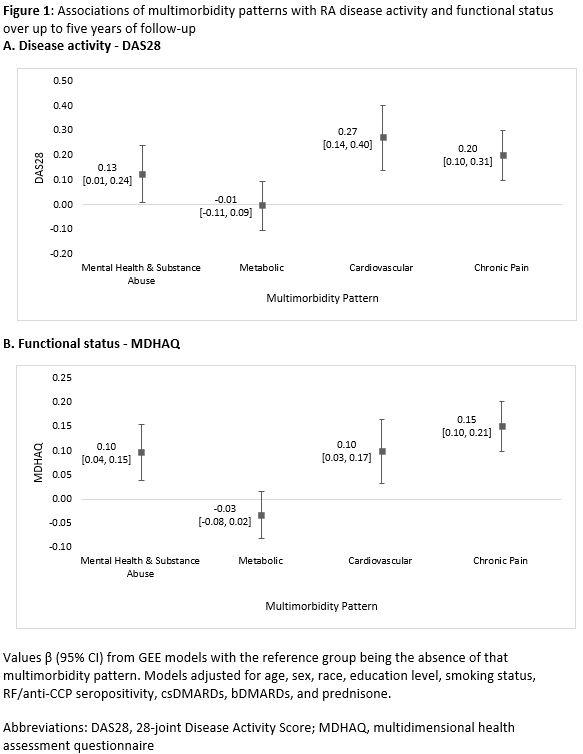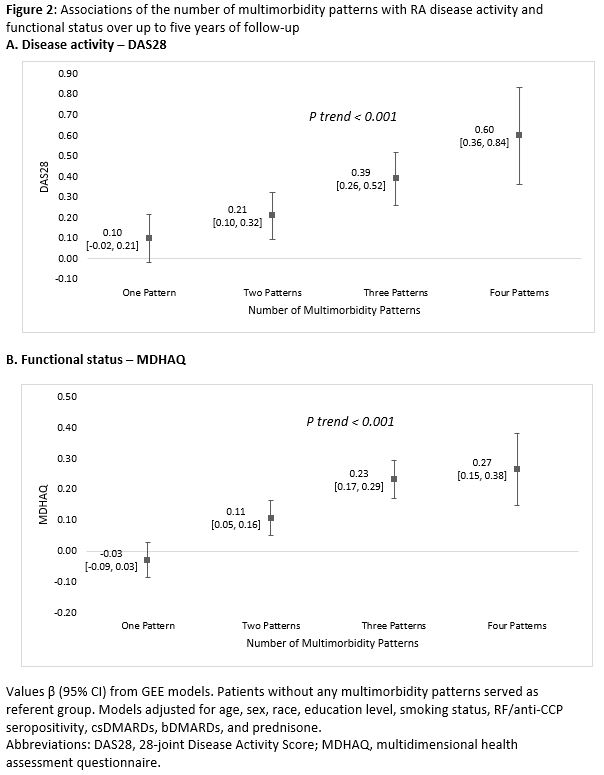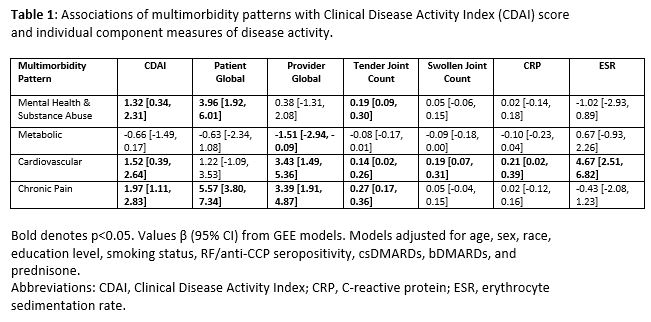Back
Poster Session C
Rheumatoid arthritis (RA)
Session: (1387–1416) RA – Diagnosis, Manifestations, and Outcomes Poster III
1390: Distinct Patterns of Multimorbidity Are Associated with Longitudinal Disease Activity and Functional Status in a Multicenter, Prospective Rheumatoid Arthritis Cohort
Sunday, November 13, 2022
1:00 PM – 3:00 PM Eastern Time
Location: Virtual Poster Hall
- SD
Sarah Dutt, -None-
University of Nebraska Medical Center
Omaha, NE, United States
Abstract Poster Presenter(s)
Sarah Dutt1, Punyasha Roul2, Yangyuna Yang3, Kaleb Michaud3, Brian Sauer4, Grant Cannon5, Joshua Baker6, Jeffrey Curtis7, Ted Mikuls8 and Bryant England3, 1University of Nebraska Medical Center, Omaha, 2UNMC, Omaha, NE, 3University of Nebraska Medical Center, Omaha, NE, 4Salt Lake City VA/University of Utah, Salt Lake City, UT, 5Salt Lake City VA, Salt Lake city, 6University of Pennsylvania and Corporal Michael J. Crescenz VA Medical Center, Philadelphia, 7Division of Clinical Immunology & Rheumatology, University of Alabama at Birmingham, Birmingham, AL, 8Division of Rheumatology, University of Nebraska Medical Center, Omaha, NE
Background/Purpose: Rheumatoid arthritis (RA) predisposes to the development of other chronic conditions such as osteoporosis, cardiovascular disease, and lung disease. Previously, we used unsupervised machine learning and real-world data to derive novel patterns of multimorbidity that were overrepresented in patients with RA and included mental health and substance abuse, cardiovascular, metabolic, and chronic pain multimorbidity. The prognostic value of these multimorbidity patterns for RA-related outcomes is unknown.
Methods: We performed a cohort study using the Veterans Affairs Rheumatoid Arthritis (VARA) Registry, a multicenter, prospective RA cohort. The presence of forty-four chronic conditions was assessed through diagnostic codes from outpatient and inpatient encounters using linked administrative data. Patients were then assigned the previously identified multimorbidity patterns based on these conditions prior to enrollment. Additionally, we assessed the number of unique multimorbidity patterns present in each patient. RA disease activity (28-joint Disease Activity Score [DAS28]) and functional status (multidimensional Health Assessment Questionnaire [MDHAQ]) were collected longitudinally per routine care and averaged over each year of follow-up. Associations of these patterns with DAS28, MDHAQ, and individual RA disease activity measure components over up to 5-years of follow-up was determined using generalized estimating equations (GEE) adjusting for relevant covariates such as demographics, smoking status, RA autoantibodies, and medications. Interaction terms tested between multimorbidity patterns and follow-up duration were not significant (all p >0.20).
Results: Results: We studied 2,941 RA patients, of which the majority were male (88.4%), had a smoking history (79.3%), and RF or anti-CCP seropositive (85.8%). The metabolic multimorbidity pattern was most frequent (64.2%), followed by chronic pain (48.6%), mental health and substance abuse (23.2%), and cardiovascular multimorbidity (12.4%). Patients with mental health and substance abuse, cardiovascular, and chronic pain patterns of multimorbidity had higher DAS28 and MDHAQ values throughout follow-up (Figure 1). Similar findings were observed with the Clinical Disease Activity Index (Table 1). Metabolic multimorbidity was not associated with DAS28 or MDHAQ. A greater number of multimorbidity patterns was associated with higher DAS28 and MDHAQ scores (p trend < 0.001 for both, Figure 2). Mental health and substance abuse as well as chronic pain multimorbidity tended to be associated with patient and provider global scores and tender joint count (Table 1). The cardiovascular pattern of multimorbidity was associated with provider global scores, tender and swollen joint count, and acute phase reactants.
Conclusion: The presence of mental health and substance abuse, chronic pain, and cardiovascular patterns of multimorbidity was associated with higher RA disease activity and poorer functional status in RA. Identifying and addressing these different patterns of multimorbidity as part of holistic care may facilitate achievement of RA treatment targets and improve long-term patient outcomes.
 Figure 1: Associations of multimorbidity patterns with RA disease activity and functional status over up to five years of follow-up
Figure 1: Associations of multimorbidity patterns with RA disease activity and functional status over up to five years of follow-up
 Figure 2: Associations of the number of multimorbidity patterns with RA disease activity and functional status over up to five years of follow-up
Figure 2: Associations of the number of multimorbidity patterns with RA disease activity and functional status over up to five years of follow-up
 Table 1: Associations of multimorbidity patterns with Clinical Disease Activity Index (CDAI) score and individual component measures of disease activity.
Table 1: Associations of multimorbidity patterns with Clinical Disease Activity Index (CDAI) score and individual component measures of disease activity.
Disclosures: S. Dutt, None; P. Roul, None; Y. Yang, None; K. Michaud, None; B. Sauer, None; G. Cannon, None; J. Baker, Bristol Myers Squibb, Pfizer, CorEvitas LLC, Burns-White, LLC, RediTrex; J. Curtis, Amgen, Bristol-Myers Squibb (BMS), CorEvitas, IlluminationHealth, Janssen, Lilly, Myriad, Novartis, Pfizer, Sanofi, UCB, Aqtual, Bendcare, FASTER, GlaxoSmithKlein (GSK), Labcorp, Scipher, Setpoint, United Rheumatology, AbbVie, ArthritisPower; T. Mikuls, Gilead Sciences, Bristol-Myers Squibb, Horizon, Sanofi, Pfizer Inc; B. England, Boehringer-Ingelheim.
Background/Purpose: Rheumatoid arthritis (RA) predisposes to the development of other chronic conditions such as osteoporosis, cardiovascular disease, and lung disease. Previously, we used unsupervised machine learning and real-world data to derive novel patterns of multimorbidity that were overrepresented in patients with RA and included mental health and substance abuse, cardiovascular, metabolic, and chronic pain multimorbidity. The prognostic value of these multimorbidity patterns for RA-related outcomes is unknown.
Methods: We performed a cohort study using the Veterans Affairs Rheumatoid Arthritis (VARA) Registry, a multicenter, prospective RA cohort. The presence of forty-four chronic conditions was assessed through diagnostic codes from outpatient and inpatient encounters using linked administrative data. Patients were then assigned the previously identified multimorbidity patterns based on these conditions prior to enrollment. Additionally, we assessed the number of unique multimorbidity patterns present in each patient. RA disease activity (28-joint Disease Activity Score [DAS28]) and functional status (multidimensional Health Assessment Questionnaire [MDHAQ]) were collected longitudinally per routine care and averaged over each year of follow-up. Associations of these patterns with DAS28, MDHAQ, and individual RA disease activity measure components over up to 5-years of follow-up was determined using generalized estimating equations (GEE) adjusting for relevant covariates such as demographics, smoking status, RA autoantibodies, and medications. Interaction terms tested between multimorbidity patterns and follow-up duration were not significant (all p >0.20).
Results: Results: We studied 2,941 RA patients, of which the majority were male (88.4%), had a smoking history (79.3%), and RF or anti-CCP seropositive (85.8%). The metabolic multimorbidity pattern was most frequent (64.2%), followed by chronic pain (48.6%), mental health and substance abuse (23.2%), and cardiovascular multimorbidity (12.4%). Patients with mental health and substance abuse, cardiovascular, and chronic pain patterns of multimorbidity had higher DAS28 and MDHAQ values throughout follow-up (Figure 1). Similar findings were observed with the Clinical Disease Activity Index (Table 1). Metabolic multimorbidity was not associated with DAS28 or MDHAQ. A greater number of multimorbidity patterns was associated with higher DAS28 and MDHAQ scores (p trend < 0.001 for both, Figure 2). Mental health and substance abuse as well as chronic pain multimorbidity tended to be associated with patient and provider global scores and tender joint count (Table 1). The cardiovascular pattern of multimorbidity was associated with provider global scores, tender and swollen joint count, and acute phase reactants.
Conclusion: The presence of mental health and substance abuse, chronic pain, and cardiovascular patterns of multimorbidity was associated with higher RA disease activity and poorer functional status in RA. Identifying and addressing these different patterns of multimorbidity as part of holistic care may facilitate achievement of RA treatment targets and improve long-term patient outcomes.
 Figure 1: Associations of multimorbidity patterns with RA disease activity and functional status over up to five years of follow-up
Figure 1: Associations of multimorbidity patterns with RA disease activity and functional status over up to five years of follow-up Figure 2: Associations of the number of multimorbidity patterns with RA disease activity and functional status over up to five years of follow-up
Figure 2: Associations of the number of multimorbidity patterns with RA disease activity and functional status over up to five years of follow-up Table 1: Associations of multimorbidity patterns with Clinical Disease Activity Index (CDAI) score and individual component measures of disease activity.
Table 1: Associations of multimorbidity patterns with Clinical Disease Activity Index (CDAI) score and individual component measures of disease activity.Disclosures: S. Dutt, None; P. Roul, None; Y. Yang, None; K. Michaud, None; B. Sauer, None; G. Cannon, None; J. Baker, Bristol Myers Squibb, Pfizer, CorEvitas LLC, Burns-White, LLC, RediTrex; J. Curtis, Amgen, Bristol-Myers Squibb (BMS), CorEvitas, IlluminationHealth, Janssen, Lilly, Myriad, Novartis, Pfizer, Sanofi, UCB, Aqtual, Bendcare, FASTER, GlaxoSmithKlein (GSK), Labcorp, Scipher, Setpoint, United Rheumatology, AbbVie, ArthritisPower; T. Mikuls, Gilead Sciences, Bristol-Myers Squibb, Horizon, Sanofi, Pfizer Inc; B. England, Boehringer-Ingelheim.

